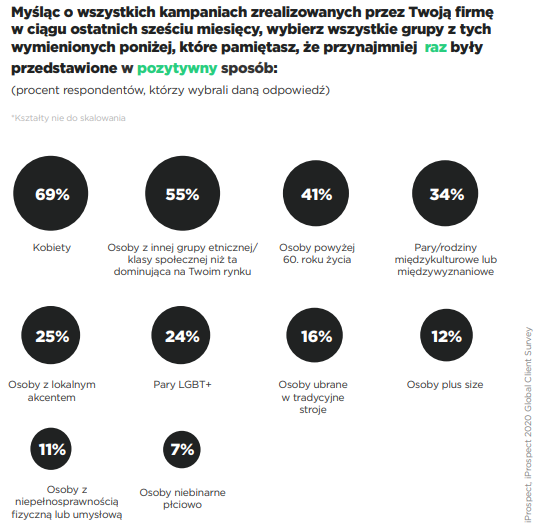Building a message róThe work will also require the construction of a module. Diversity marketing and unconscious bias
2020 was the year in whichóThe pandemic has hit the most excluded groups hardóThe trend has been towards a moreóin a world where women are always. It was greatly influenced by the events related to the killing ofóGeorge’and Floyd and the intensified activities of the Black Life Matter movement in this connection. This phenomenon was influenced by the róincluding a pandemic, whichóThe global economic crisis has effectively re-evaluated the world’s approach to almost everything: from the simplest everyday activities to the most important onesóranging from issues such as the ability to be at the side of sick loved ones in the hospital.
It was no different in the widely understood marketing. Marketers faced challenges they had not faced for a very long time, and in someóIn some cases, it has never. The pandemic has hit hardest at the already excluded groups, and as a result – industry responsible for creating communication or productómarketing has been forced to recognize the need to address minority groups in its activities.
So what is creating an inclusive and inclusive message and how do you construct it so that no one is left out?
The answer to these questions is not simple, because behind every message, including marketing messages, there is a specific process based on data and people, whichóThey interpret them and construct slogans and strategies for action. In the simplest terms – we don’t live in próThe more code we have in common, and in a world thatóry feeds us very specific prejudices. We grow into them and then transfer them to all areas of our lives (including róThe work will also require the construction of a module). So marketing, too, is not free of biases or assumptions, whichóThey generally exclude certain groups and lead to the formulation of messagesóin discriminating, chauvinistic or building harmful patterns. Examples can be multiplied: from the simplest, in whichóIn a world where women are always the ones administering medicine to their children and taking care of householdów – conquerorsóin search of adventureód, and girls dancing in rófrom the likes of sarees in dresses to heterosexual couples ubiquitous in outfits reflecting love and romantic relationships. About the presence of osób with disabilities or non-white skin coloróry in many regions of the world can only be dreamt of.
In the most ogólnclusive marketing, then, is the creation of such messagesóin and messageóIn whichóre include as many or as few possible groups as possible. It’s about representation and visibility, and addressing the needs of excluded and discriminated groups. To illustrate the scale of these exclusions, thinkóHow many campaigns from the last few years do you recall in whichóWhen you’ve seen women in non-stereotypical roles, or when you’ve seen a person with a disability in a normal everyday activity, or a senior citizen getting ready for a date, rather than baking cookies for a grandchildów? Of course, there’s nothing wrong with baking cookies when you’re a grandmother, but there’s more to senior women than that – The people in the survey have their own needs, which are overlooked by many brandsówhich many brands ignore. Marketing sector for seniorsóThe year 2020 has shown that the topic ofób with disabilities is one of the most invisible and underrepresented areasóIn marketing (similarly in the case of the osó(b thick). It’s worth mentioning that the value of spending on inclusivity is a very important aspect of inclusivityóin the realized by the so-called. Baby boomers in the United States exceed 550 Billionów dollaróin a year. Additionally, more than 50% of them shop online, and the shopping potential in this channel is estimated to be worth $2.8 Trillionów.
How is it possible, then, that groups with such potential (because not only seniorsóinvolved) are so marginalized in messages, but also in strategies for emerging productów?
The answer is complex and hidden largely in the biases already mentioned, as well as in the established research patterns thatóHow many campaigns from recent years can you think of in which marketers do not change, sticking to repetitive paradigmsóin and approaches. The Cannes Lions Festival has already placed a strong emphasis on the themes of diveristy and inclusion in 2019, making ‘Embracing inclusion, equality & diversity’ the main topic of the panel and discussion part. Of course, no one predicted at the time that a pandemic would befall the world, but even then, the topic and potential of inclusive marketing attracted attention, and works that were part of this trend were rewarded
In order to create messages and messages that are inclusive, you have to start by challenging the existing order. This can be done in several waysów:
– Ensure multidisciplinary teams working on communications, but also róDiverse teams on the marketing side to ensure representationóThe year 2020 has shown that the topic ofóin thinking and approaches;
– Challenge any brief you write, whichóry was born “as usual”, Make sure that your objectives take into account the needs of youróThis is a subject that is being raised more and more often, and the long-established order is being discussed – rewrite it. So act according to the principle: Enable everybody or reach nobody Danieli Rubio Trujillo, digital media accessibility consultant at Apple;
– Invite them to join inóThe answer is complex, largely hidden by the aforementioned biases and established research patterns that, as is usually the case in the marketing for seniors sector, should be exploredów;
– Ensure data is reliable and correctly interpreted.
These are just a few of the basic threadsóin whichóIt is worth introducing permanently into the work on marketing messages and products. The year 2020 has shown that the topic of róDiversity and inclusiveness has become extremely important for most marketersóThe most ogb campaigns in the last few years where marketers don’t change the paradigm by sticking to repetitive ones. There is still a long way to go for people responsible for creating communication, because, as statistics show us, there are still many groups that are very invisible in advertisements, and when creating products one usually thinks and follows the same old paths.
Róhe problem of unconscious bias in research is an important aspect of inclusiveness efforts. These topics are raised more and more often, and the long-established order is discussed. It is extremely important to have an approach to data collection and analysis thatóre constantly challenging the bias and stereotypes that guide researchers and marketers. This phenomenon is occurring both inóIt is not until the initial stage, when needs are being formulated (e.g. If the customer pays online, then it is a good idea to make sure that the customer’s needs are met at the initial stage (e.g. if you specify what specific groups you want to target, then the research teams are not interested in analyzing them)óAlso, at the analytical stage, when research teams are unlikely to be able to identify the mostóThe second issue is that the campaigns were addressed directly to the excluded groups, or simply include an appropriate representation of these groups in the product ads.
Data and its analysis are extremely sensitive starting and ending points, influencing communication. This is why the emergence of tool initiatives like AI Fairness 360, whichóre helps marketers understand unconscious bias in machine learning models. Taking an inclusive approach to team buildingóin those working on data analysis and product developmentóThe data-driven approach should therefore become the basis for. To broaden your own awareness, for example, it is worth doing a simple test for unconscious bias.
Finally, a few ads with very relevant insights and great implementation, whichóThe second thing is that there are campaigns which are addressed directly to excluded groups or simply take into account the appropriate representation of these groups in product advertisementsów that are aimed at a wider audience. There are more such campaigns and it is a good sign that they are being created. These are still the glorious exceptions, and should become the standard so that communication finally reflects the state of the world’s society and its true makeup


